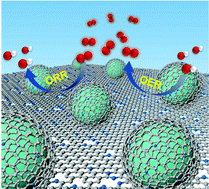Superior oxygen electrocatalysts derived from predesigned covalent organic polymers for zinc–air flow batteries†
Abstract
Covalent organic polymers (COPs) as emerging porous materials with ultrahigh hydrothermal stability and well-defined and adjustable architectures have aroused great interest in the electrochemical field. Here, we reported a rational design approach for the preparation of a bifunctional electrocatalyst with the assistance of a predesigned bimetallic covalent organic polymer. With the predesigned nitrogen position and structural features of COP materials, the obtained CCOPTDP–FeNi–SiO2 catalyst affords a remarkable bifunctional performance with a positive half-wave potential (0.89 V vs. reversible hydrogen electrode: RHE, superior to the benchmark Pt/C) for ORR activity, and a low overpotential (0.31 V better than the benchmark IrO2) at 10 mA cm−2 for OER activity in alkaline solution. The potential gap between E1/2 and Ej=10 reaches 0.650 V, in line with that observed in the current state-of-the-art bifunctional oxygen electrode materials. Moreover, a homemade rechargeable Zn–air flow battery using the CCOPTDP–FeNi–SiO2 catalyst as an air cathode exhibits an almost twofold power density (112.8 vs. 64.8 mW cm−2) and a lower charge–discharge voltage gap, compared with a commercialized noble Pt/C + IrO2/C-driven Zn–air flow battery. More importantly, the CCOPTDP–FeNi–SiO2-driven battery maintains a better cycling stability compared to a noble metal-driven battery without performance decay. Accordingly, this work will open up new ways for fabricating practical oxygen electrodes for, but not limited to, metal air based battery applications.



 Please wait while we load your content...
Please wait while we load your content...